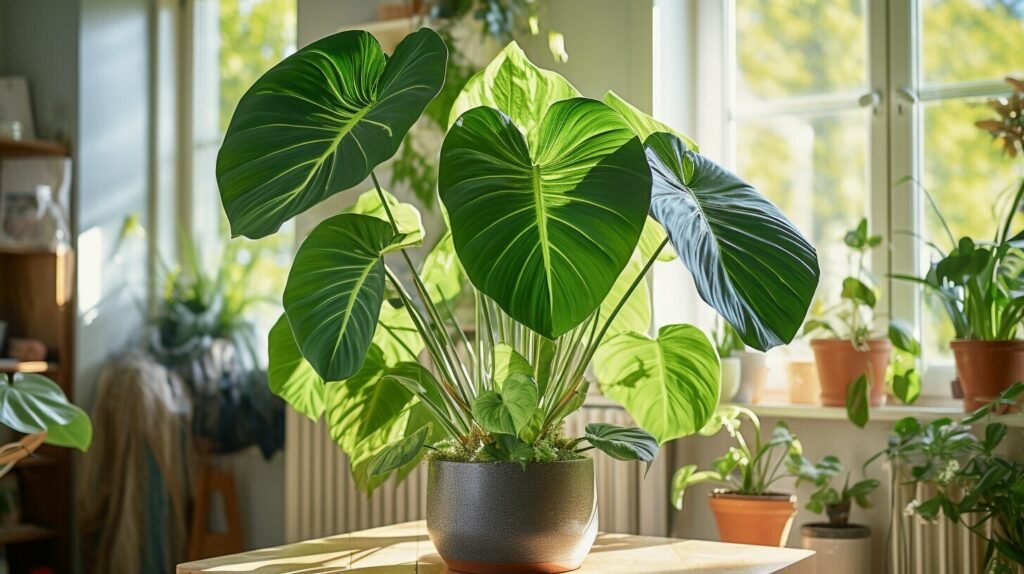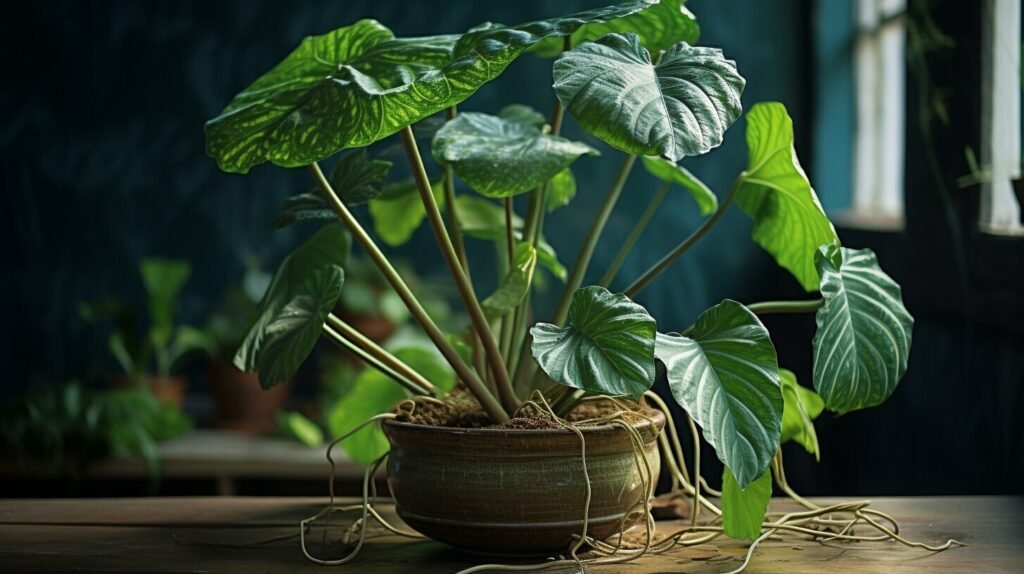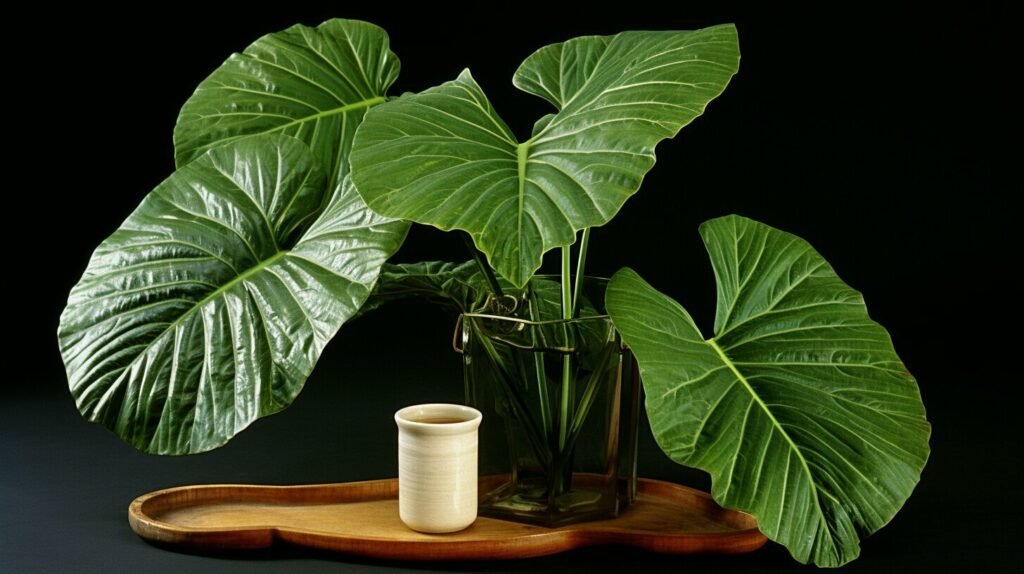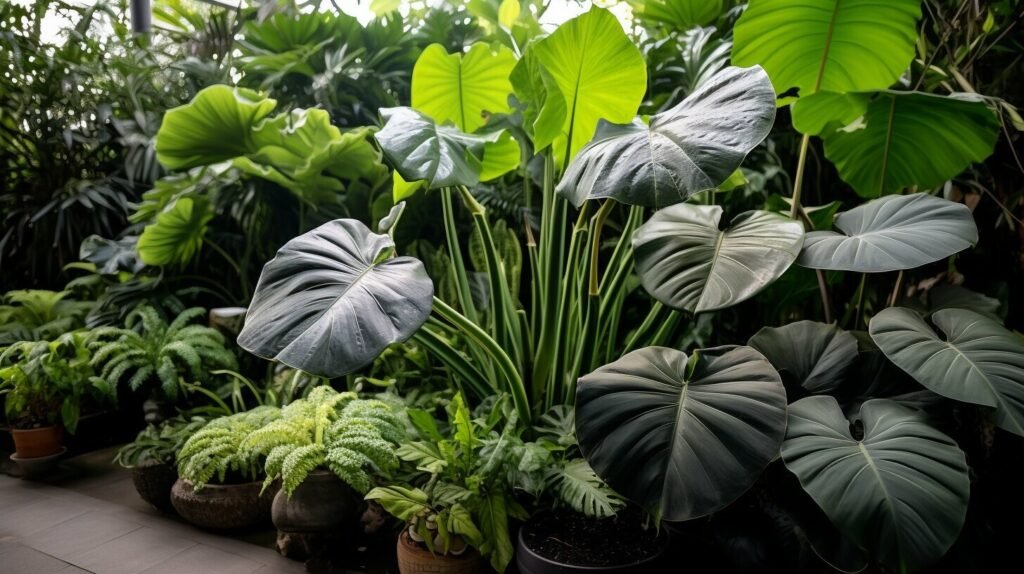Alocasia Jacklyn is a stunning and highly sought-after plant with vibrant green foliage and the shape of a stag’s head. In this ultimate plant care guide, I will share valuable tips and instructions to help you successfully grow and nurture your Alocasia Jacklyn.
- Alocasia Jacklyn is a rare plant that is highly sought after by collectors for its unique characteristics and beautiful foliage.
- It requires medium to bright indirect light and moist, well-drained soil to thrive.
- Maintaining warm temperatures and high humidity is crucial for the optimal growth of Alocasia Jacklyn.
- Regular fertilizing and pruning are essential for its overall health and longevity.
- Propagation can be done through dividing rhizomes or using offsets, ensuring successful growth and multiplication.
Now that you have an introduction to Alocasia Jacklyn, let’s dive deeper into understanding this remarkable plant and how to provide it with the ideal conditions for its well-being.
Understanding Alocasia Jacklyn: A Plant Collector’s Dream
Alocasia Jacklyn is a recently discovered plant that has captured the hearts of plant enthusiasts and collectors. With its stunning green foliage adorned with dark lines and leaves shaped like a stag’s head, it truly stands out in any indoor space. This unique plant is not only visually appealing but also relatively easy to care for, making it a perfect addition to any plant lover’s collection.
The Alocasia Jacklyn plant belongs to the Alocasia genus, which includes other popular varieties such as Alocasia Polly and Alocasia Amazonica. However, what sets Jacklyn apart is its distinct leaf shape and intricate patterns. Each leaf resembles a majestic stag’s head, mesmerizing its admirers with its beauty and elegance.
In addition to its striking appearance, Alocasia Jacklyn thrives in medium to bright indirect light conditions, making it highly adaptable to different indoor environments. It prefers moist, well-drained soil and requires regular watering to keep its soil consistently moist. It is important to note that overwatering can result in root rot, so allowing the top layer of soil to dry out between waterings is essential.
With proper care, Alocasia can grow up to two feet tall, making it a standout plant in any collection. Its unique foliage and easy care requirements have made it a highly sought-after plant among collectors, so if you’re lucky enough to find one for sale, be sure to grab it and add this stunning plant to your indoor jungle.
| Plant Name | Foliage Color | Leaf Shape |
|---|---|---|
| Alocasia Jacklyn | Green with dark lines | Stag’s head-shaped |
| Alocasia Polly | Green | Arrow-shaped |
| Alocasia Amazonica | Green with white veins | Arrow-shaped |
Providing the Ideal Conditions: Alocasia Jacklyn Care Tips
To ensure your Alocasia Jacklyn thrives, it is vital to provide it with the ideal conditions. This section will guide you through the essential care tips, including light, soil, temperature, humidity, fertilizing, and pruning.
Light: Alocasia Jacklyn prefers medium to bright indirect light. Place it near a north or east-facing window where it can receive filtered sunlight. Avoid direct sunlight, as it can scorch the leaves.
Soil: Use well-drained soil to prevent overwatering, as Alocasia Jacklyn is susceptible to root rot. A mixture of peat moss, perlite, and potting soil works well. Ensure the pot has drainage holes to allow excess water to escape.
Temperature and Humidity: Alocasia Jacklyn thrives in warm temperatures between 65-85°F (18-29°C). Keep the plant away from cold drafts and sudden temperature changes. It also benefits from high humidity levels, so mist the leaves regularly or place a tray of water nearby to increase humidity.
Fertilizing and Pruning: During the growing season, which is typically spring and summer, fertilize your Alocasia Jacklyn once a month using a balanced liquid fertilizer. Pruning is necessary to maintain its shape and remove any damaged or yellowing leaves. Simply trim close to the base of the plant using clean, sharp pruning shears.

| Care Tips | Description |
|---|---|
| Light | Medium to bright indirect light, avoid direct sunlight |
| Soil | Well-drained soil mixture, with peat moss, perlite, and potting soil |
| Temperature | Warm temperatures between 65-85°F (18-29°C) |
| Humidity | High humidity, mist leaves or use a humidity tray |
| Fertilizing | Monthly with a balanced liquid fertilizer during the growing season |
| Pruning | Remove damaged or yellowing leaves, trim close to the base |
Propagating Alocasia Jacklyn: Dividing Rhizomes and Offsets
If you want to expand your Alocasia Jacklyn collection or share this stunning plant with others, propagation through dividing rhizomes or using offsets is a great option. In this section, I will walk you through the process, providing clear instructions and tips for successful propagation.
First, let’s talk about dividing rhizomes. Rhizomes are underground stems that produce roots and shoots. To propagate Alocasia Jacklyn using this method, start by carefully removing the plant from its pot. Gently shake off any excess soil to reveal the rhizomes. Look for healthy rhizomes that have several growth points or eyes. Use a clean, sharp knife to separate these rhizomes, ensuring that each division has at least one eye and a good portion of roots.
Next, prepare a new pot with well-drained soil and place the divided rhizomes on top, making sure the eyes are facing up. Cover them with a layer of soil and lightly press it down to secure the rhizomes. Water the newly potted divisions thoroughly and place the pot in a warm, humid location with bright, indirect light. Keep the soil consistently moist but not waterlogged to encourage root development and new growth.
Using offsets
Offsets are small plantlets that grow around the base of the parent plant. This method of propagation is ideal when your Alocasia Jacklyn naturally produces these offsets. To propagate using offsets, carefully remove them from the parent plant once they have developed their own roots and leaves. It’s important to ensure that the offset has enough roots to sustain itself before detaching it.
Similar to dividing rhizomes, prepare a new pot with well-drained soil and plant the offsets at the same depth as their original position. Water the soil thoroughly and place the pot in a warm, humid location with bright, indirect light. Maintain consistent moisture levels, and soon you’ll witness new growth and the development of a mature Alocasia Jacklyn plant.
Remember, patience is key when propagating Alocasia Jacklyn. It may take some time for the new divisions or offsets to establish themselves and grow. But with the right care and attention, you’ll soon have a flourishing collection of these beautiful plants.
| Propagation Method | Instructions |
|---|---|
| Dividing Rhizomes | – Carefully remove the plant from its pot – Shake off excess soil, revealing the rhizomes – Separate healthy rhizomes with multiple eyes using a clean, sharp knife – Plant divisions in a new pot with well-drained soil, ensuring eyes face up – Keep soil consistently moist, in a warm, humid location with bright, indirect light |
| Using Offsets | – Carefully remove offsets once they have developed roots and leaves – Plant offsets in a new pot with well-drained soil at the same depth as their original position – Keep soil consistently moist, in a warm, humid location with bright, indirect light |
Repotting for Growth: When and How to Repot Alocasia Jacklyn
As your Alocasia Jacklyn grows and thrives, the time will come when it needs to be repotted. This section will guide you through the process, explaining when and how to repot your plant for continued growth and vitality. Repotting is essential to ensure that your Alocasia Jacklyn has enough room to spread its roots and access fresh nutrients in the soil. It also helps prevent root bound, which can hinder its growth.
When to Repot
Knowing when to repot your Alocasia Jacklyn is crucial for its well-being. Look for the following signs that indicate it’s time to repot:
1. Roots emerging from the drainage holes: If you notice roots poking out from the pot’s bottom, it’s a clear indication that your plant needs more space.
2. Slow growth or stunted leaves: If your Alocasia Jacklyn isn’t growing as vigorously as before or if the leaves appear smaller than usual, it’s a sign that the plant has outgrown its current pot.
3. Water not being absorbed properly: If water runs through the pot without being absorbed by the soil, it means that the roots have filled the pot, and repotting is necessary.
How to Repot
Follow these steps to repot your Alocasia Jacklyn:
1. Choose the right pot: Select a pot that is one size larger than the current one to allow for future growth. Ensure that it has drainage holes to prevent waterlogging.
2. Prepare the new pot: Fill the bottom with a layer of fresh, well-draining potting mix.
3. Gently remove the plant: Carefully slide your Alocasia Jacklyn out of its current pot, ensuring not to damage the roots.
4. Loosen the roots: Gently loosen the root ball with your hands, removing any excess soil. This will encourage new root growth and prevent the roots from becoming pot-bound.
5. Place the plant in the new pot: Position the plant in the center of the new pot and add fresh potting mix around the roots, gently pressing it down to secure the plant.
6. Water thoroughly: After repotting, give your Alocasia Jacklyn a thorough watering to help settle the soil and eliminate any air pockets around the roots.
Remember to place your newly repotted Alocasia Jacklyn in a warm and humid environment, as it may experience some transplant shock. Keep an eye on its progress and continue to provide the care it needs to thrive.
For more details and visual guidance on repotting your Alocasia Jacklyn, refer to the table below:
| Step | Description |
|---|---|
| 1 | Choose the right pot |
| 2 | Prepare the new pot |
| 3 | Gently remove the plant |
| 4 | Loosen the roots |
| 5 | Place the plant in the new pot |
| 6 | Water thoroughly |
Following these instructions and providing your Alocasia Jacklyn with the care it needs will ensure its continued growth and vitality. Enjoy watching your plant thrive in its new pot and create a beautiful green oasis in your home.

Troubleshooting Common Issues: Dealing with Yellowing Leaves and Pests
Even with proper care, Alocasia Jacklyn can face some common issues. In this section, I will help you troubleshoot problems like yellowing leaves, brown leaves, and pest infestations, offering valuable tips to remedy these issues.
Yellowing Leaves: If you notice your Alocasia leaves turning yellow, it could be a sign of overwatering or underwatering. Check the soil moisture by sticking your finger about an inch deep into the soil. If it feels dry, it’s time to water. However, if it feels excessively wet, reduce watering frequency. Adjusting your watering routine should help restore the health of your plant.
Brown Leaves: Brown leaves on your Alocasia Jacklyn can be caused by a few different factors. One common reason is inadequate humidity levels. To increase humidity, consider using a humidifier or placing a tray filled with water near the plant. Another possibility is direct exposure to sunlight. Ensure your plant is receiving bright but indirect light, as too much direct sunlight can lead to leaf scorching.
Alocasia can sometimes attract pests like spider mites or mealybugs. If you notice tiny webs or cotton-like clusters on the leaves, it’s a sign of infestation. To tackle these pests, you can use a mixture of water and mild soap to gently wipe the affected areas. Alternatively, you can use insecticidal soap or neem oil, following the instructions on the product label. Regularly inspecting your plant and taking prompt action can help prevent further damage.
Remember, troubleshooting issues with your Alocasia Jacklyn requires patience and attentiveness. By addressing these common problems early on, you can ensure the continued health and vibrancy of your beloved plant.

| Issue | Cause | Solution |
|---|---|---|
| Yellowing Leaves | Overwatering or underwatering | Check soil moisture and adjust watering accordingly |
| Brown Leaves | Inadequate humidity or direct sunlight | Increase humidity and provide indirect light |
| Pest Infestations | Spider mites or mealybugs | Use mild soap, insecticidal soap, or neem oil to eliminate pests |
Finding Alocasia Jacklyn: Where to Buy this Rare Plant
If you’re on the hunt for an Alocasia Jacklyn to add to your collection, this section will guide you to the right sources. While this plant is rare, there are plant shops and online sellers where you may be able to find the coveted Alocasia Jacklyn.
When it comes to finding one, a good place to start is by checking with specialized plant shops and nurseries. These establishments often stock a wide variety of unique and hard-to-find plants, making them a great resource for plant collectors. Give them a call or visit their websites to inquire about the availability of Alocasia Jacklyn.
If you prefer the convenience of online shopping, there are also several online sellers that offer Alocasia Jacklyn plants. Websites like Etsy, eBay, and specialized plant retailers often have listings for this rare plant. Keep in mind that availability may vary, so be sure to check regularly or set up alerts to be notified when new plants become available.
Remember to do your research and buy from reputable sellers who have positive reviews and a track record of delivering healthy plants. It’s essential to ensure that the seller provides proper packaging and shipping to protect the delicate foliage during transit.

Whether you choose to visit a physical store or explore online sources, finding an Alocasia Jacklyn plant for your collection is an exciting adventure. Keep in mind that due to its rarity, the availability of this plant may be limited. Patience and persistence are key, so don’t get discouraged if you don’t find it right away. Take your time, and soon enough, you may be rewarded with the stunning Alocasia Jacklyn to grace your indoor garden.
Conclusion
Congratulations on completing the ultimate plant care guide for Alocasia Jacklyn! By following these tips and instructions, you’ll be well-equipped to nurture this remarkable plant and enjoy its beauty in your indoor space.
Alocasia Jacklyn is a recently discovered plant that has quickly become a favorite among collectors. With its vivid green foliage adorned with dark lines and the unique shape resembling a stag’s head, it adds a touch of exotic beauty to any room.
Proper care is essential for the health and vitality of Alocasia Jacklyn. It thrives in medium to bright indirect light, so be sure to place it near a window where it can receive ample sunlight. The plant also prefers moist, well-drained soil and warm temperatures with high humidity. You can achieve this by misting the leaves regularly or using a humidifier.
To keep your Alocasia Jacklyn thriving, fertilize it monthly during the spring and summer months and prune as needed to maintain its shape and size. You can also propagate the plant by dividing its rhizomes or using offsets, allowing you to expand your collection or share this rare plant with others.
Keep an eye out for signs of yellowing leaves, brown leaves, or drooping, as these may indicate issues with watering or temperature. Avoid overwatering, as it can lead to root rot, and protect your plant from pests by regularly inspecting its leaves and using natural pest control methods if necessary.
While it is a sought-after plant, it can be found for sale at some plant shops. If you’re lucky enough to get your hands on one, follow the care tips in this guide, and you’ll be rewarded with a thriving and beautiful addition to your indoor garden.
What Could Be Stunting the Growth of My Alocasia Jacklyn Plant?
If you’re experiencing alocasia growth troubleshooting mystery with your Alocasia Jacklyn plant, consider factors like inadequate lighting, improper watering, or lack of nutrients. Ensuring the plant has the right environment and proper care can help identify and address any issues stunting its growth.
FAQ
Q: How much light does Alocasia Jacklyn need?
A: Alocasia Jacklyn thrives in medium to bright indirect light. Avoid placing it in direct sunlight, as this can burn the leaves.
Q: What kind of soil does Alocasia Jacklyn prefer?
A: Alocasia Jacklyn requires moist, well-drained soil. A mixture of potting soil, peat moss, and perlite works well to provide proper drainage.
Q: What temperature and humidity does Alocasia Jacklyn prefer?
A: Alocasia Jacklyn prefers warm temperatures between 65-85°F (18-29°C) and high humidity. Consider using a humidifier or placing the plant on a tray of water to increase humidity levels.
Q: How often should I fertilize Alocasia Jacklyn?
A: Fertilize Alocasia Jacklyn monthly during the spring and summer using a balanced, water-soluble fertilizer. Follow the package instructions for proper dosage.
Q: Can I propagate Alocasia Jacklyn?
A: Yes, Alocasia Jacklyn can be propagated by dividing the rhizomes or using offsets. Carefully separate the rhizomes or offsets and plant them in separate pots with fresh soil.
Q: How often should I repot Alocasia Jacklyn?
A: It is recommended to repot Alocasia Jacklyn every 2-3 years. Choose a pot that is slightly larger than the current one and use fresh soil to promote healthy growth.
Q: What should I do if the leaves of my Alocasia Jacklyn turn yellow or brown?
A: Yellowing or browning leaves may indicate watering or temperature issues. Ensure that you are not overwatering or underwatering the plant and check if the temperature is within its preferred range. Adjust as necessary.
Q: How can I protect my Alocasia Jacklyn from pests?
A: To protect your Alocasia Jacklyn from pests, regularly inspect the plant for signs of infestation. If you notice any pests, such as aphids or spider mites, treat them with a gentle insecticidal soap or neem oil spray.
Q: Where can I buy Alocasia Jacklyn?
A: Alocasia Jacklyn is a rare plant but can sometimes be found for sale at plant shops or online sources that specialize in unique and exotic plants.

